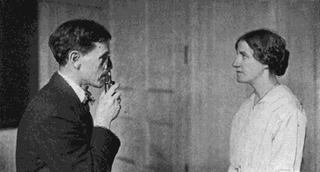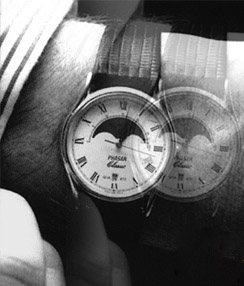Related Research Articles

Glasses, also known as eyeglasses or spectacles, are vision eyewear with clear or tinted lenses mounted in a frame that holds them in front of a person's eyes, typically utilizing a bridge over the nose and hinged arms, known as temples or temple pieces, that rest over the ears.
Photokeratitis or ultraviolet keratitis is a painful eye condition caused by exposure of insufficiently protected eyes to the ultraviolet (UV) rays from either natural or artificial sources. Photokeratitis is akin to a sunburn of the cornea and conjunctiva.

Laser-Assisted in Situ Keratomileusis (LASIK), commonly referred to as laser eye surgery or laser vision correction, is a type of refractive surgery for the correction of myopia, hyperopia, and an actual cure for astigmatism, since it is in the cornea. LASIK surgery is performed by an ophthalmologist who uses a laser or microkeratome to reshape the eye's cornea in order to improve visual acuity.

The Bates method is an ineffective and potentially dangerous alternative therapy aimed at improving eyesight. Eye-care physician William Horatio Bates (1860–1931) held the erroneous belief that the extraocular muscles effected changes in focus and that "mental strain" caused abnormal action of these muscles; hence he believed that relieving such "strain" would cure defective vision. In 1952, optometry professor Elwin Marg wrote of Bates, "Most of his claims and almost all of his theories have been considered false by practically all visual scientists."

Presbyopia is physiological insufficiency of accommodation associated with the aging of the eye that results in progressively worsening ability to focus clearly on close objects. Also known as age-related farsightedness, it affects many adults over the age of 40. A common sign of presbyopia is difficulty reading small print which results in having to hold reading material farther away. Other symptoms associated can be headaches and eyestrain. Different people will have different degrees of problems. Other types of refractive errors may exist at the same time as presbyopia. This condition is similar to hypermetropia or far-sightedness which starts in childhood and exhibits similar symptoms of blur in the vision for close objects.
Photophobia is a medical symptom of abnormal intolerance to visual perception of light. As a medical symptom, photophobia is not a morbid fear or phobia, but an experience of discomfort or pain to the eyes due to light exposure or by presence of actual physical sensitivity of the eyes, though the term is sometimes additionally applied to abnormal or irrational fear of light, such as heliophobia. The term photophobia comes from the Greek φῶς (phōs), meaning "light", and φόβος (phóbos), meaning "fear".

Strabismus is a vision disorder in which the eyes do not properly align with each other when looking at an object. The eye that is pointed at an object can alternate. The condition may be present occasionally or constantly. If present during a large part of childhood, it may result in amblyopia, or lazy eyes, and loss of depth perception. If onset is during adulthood, it is more likely to result in double vision.

An Intraocular lens (IOL) is a lens implanted in the eye usually as part of a treatment for cataracts or for correcting other vision problems such as short sightedness and long sightedness; a form of refractive surgery. If the natural lens is left in the eye, the IOL is known as phakic, otherwise it is a pseudophakic lens. Both kinds of IOLs are designed to provide the same light-focusing function as the natural crystalline lens. This can be an alternative to LASIK, but LASIK is not an alternative to an IOL for treatment of cataracts.

Dry eye syndrome, also known as keratoconjunctivitis sicca, is the condition of having dry eyes. Symptoms include dryness in the eye, irritation, redness, discharge, blurred vision, and easily fatigued eyes. Symptoms range from mild and occasional to severe and continuous. Dry eye syndrome can lead to blurred vision, instability of the tear film, increased risk of damage to the ocular surface such as scarring of the cornea, and changes in the eye including the neurosensory system.

Refractive error is a problem with focusing light accurately on the retina due to the shape of the eye and/or cornea. The most common types of refractive error are near-sightedness, far-sightedness, astigmatism, and presbyopia. Near-sightedness results in far away objects being blurry, far-sightedness and presbyopia result in close objects being blurry, and astigmatism causes objects to appear stretched out or blurry. Other symptoms may include double vision, headaches, and eye strain.

Diplopia is the simultaneous perception of two images of a single object that may be displaced horizontally or vertically in relation to each other. Also called double vision, it is a loss of visual focus under regular conditions, and is often voluntary. However, when occurring involuntarily, it results in impaired function of the extraocular muscles, where both eyes are still functional, but they cannot turn to target the desired object. Problems with these muscles may be due to mechanical problems, disorders of the neuromuscular junction, disorders of the cranial nerves that innervate the muscles, and occasionally disorders involving the supranuclear oculomotor pathways or ingestion of toxins.

The human eye is an organ of the sensory nervous system that reacts to visible light and allows the use of visual information for various purposes including seeing things, keeping balance, and maintaining circadian rhythm.

Artificial tears are lubricating eye drops used to relieve dryness and irritation of the ocular surface. Dry eye syndrome is a common ocular surface disorder and is characterized by disruption of the tear film and increased inflammation.
Eye strain, also known as asthenopia, is a common eye condition that manifests through non-specific symptoms such as fatigue, pain in or around the eyes, blurred vision, headache, and occasional double vision. Symptoms often occur after long-term use of computers, digital devices, reading or other activities that involve extended visual tasks which are broadly classified into external and internal symptom factors.

High-energy visible light is short-wave light in the violet/blue band from 400 to 450 nm in the visible spectrum, which has a number of purported negative biological effects, namely on circadian rhythm and retinal health, which can lead to age-related macular degeneration. Increasingly, blue blocking filters are being designed into glasses to avoid blue light's purported negative effects. However, there is no good evidence that filtering blue light with spectacles has any effect on eye health, eye strain, sleep quality or vision quality.
A spasm of accommodation is a condition in which the ciliary muscle of the eye remains in a constant state of contraction. Normal accommodation allows the eye to "accommodate" for near-vision. However, in a state of perpetual contraction, the ciliary muscle cannot relax when viewing distant objects. This causes vision to blur when attempting to view objects from a distance. This may cause pseudomyopia or latent hyperopia.

Blurred vision is an ocular symptom where vision becomes less precise and there is added difficulty to resolve fine details.

GUNNAR Optiks is a company founded in 2007 that specializes in treated eyewear, marketed as safety glasses that protect eyes from computer vision syndrome. Gunnar eyewear has received considerable attention in technical media reviews, including PCWorld, Lifehacker, Huffington Post, and Gizmodo.
Tear break-up time (TBUT) also known as tear film break-up time (TFBUT) is the time taken for the first dry spot to appear on the cornea after a complete blink. TFBUT measurement is an easy and fast method used to assess the stability of tear film. It is a standard diagnostic procedure in the dry eye clinics. The volume of tear in the eye depends on two factors, drainage through the lacrimal passages and evaporation. Factors like decreased tear production, increased evaporation rate, tearfilm instability, tear hyperosmolarity, inflammations, ocular surface damages etc. can cause dryness to the eyes.
Exposure keratopathy is medical condition affecting the cornea of eyes. It can lead to corneal ulceration and permanent loss of vision due to corneal opacity.
References
- ↑ Porcar, E.; Pons, A. M.; Lorente, A. (2016). "Visual and ocular effects from the use of flat-panel displays". International Journal of Ophthalmology. 9 (6): 881–885. doi:10.18240/ijo.2016.06.16. ISSN 2222-3959. PMC 4916147 . PMID 27366692.
- ↑ Izquierdo, Natalio J.; Townsend, William. "Computer Vision Syndrome". Medscape Reference: Drugs, Diseases & Procedures. WebMD LLC. Retrieved 27 February 2012.
- ↑ "Computer Vision Syndrome Affects Millions". 2016-05-30. Archived from the original on 2018-02-10. Retrieved 2018-04-09.
- ↑ Toomingas, A.; Hagberg, M.; Heiden, M.; Richter, H.; Westergren, K. E.; Tornqvist, E. Wigaeus (1 January 2014). "Risk factors, incidence and persistence of symptoms from the eyes among professional computer users". Work (Reading, Mass.). 47 (3): 291–301. doi:10.3233/WOR-131778. PMID 24284674.
- ↑ Randolph, SA (July 2017). "Computer Vision Syndrome". Workplace Health & Safety. 65 (7): 328. doi: 10.1177/2165079917712727 . PMID 28628753. S2CID 206831504.
- ↑ Brody, Jane E. (May 31, 2016). "Millions at risk of computer vision syndrome". ET Healthworld. Archived from the original on October 8, 2017. Retrieved October 7, 2017.
- ↑ Mainstone, J. C.; Bruce, A. S.; Golding, T. R. (June 1996). "Tear meniscus measurement in the diagnosis of dry eye". Current Eye Research. 15 (6): 653–661. doi:10.3109/02713689609008906. ISSN 0271-3683. PMID 8670769.
- ↑ "Dark Mode vs. Light Mode: The Great Debate". 2023-08-09. Retrieved 2024-02-14.
- ↑ Stringham, James; Stringham, Nicole; O’Brien, Kevin (2017). "Macular Carotenoid Supplementation Improves Visual Performance, Sleep Quality, and Adverse Physical Symptoms in Those with High Screen Time Exposure". Foods. 6 (7): 47. doi: 10.3390/foods6070047 . ISSN 2304-8158. PMC 5532554 . PMID 28661438.
- 1 2 Singh, Sumeer; McGuinness, Myra B.; Anderson, Andrew J.; Downie, Laura E. (October 2022). "Interventions for the Management of Computer Vision Syndrome". Ophthalmology. 129 (10): 1192–1215. doi: 10.1016/j.ophtha.2022.05.009 . PMID 35597519. S2CID 248933081.
- ↑ Kundart, James; John R. Hayes; Yu-Chi Tai; Jim Sheedy (2007). "Gunnar Optiks Study: Accommodation and Symptoms (2007)". Pacific University Oregon: Common Knowledge. Archived from the original on 2012-07-05. Retrieved 2012-07-28.
- ↑ Tsz Wing leung; Roger Wing-hong Li; Chea-su Kee (2017). "Blue-Light Filtering Spectacle Lenses: Optical and Clinical Performances". PLOS ONE . 12 (1): e0169114. Bibcode:2017PLoSO..1269114L. doi: 10.1371/journal.pone.0169114 . PMC 5207664 . PMID 28045969.
- ↑ M, Rosenfield; RT, Li; NT, Kirsch (2020). "A double-blind test of blue-blocking filters on symptoms of digital eye strain". Work (Reading, Mass.). 65 (2): 343–348. doi:10.3233/WOR-203086. PMID 32007978. S2CID 211012744.
- ↑ Singh, Sumeer; Downie, Laura; Anderson, Andrew (2021). "Do Blue-blocking Lenses Reduce Eye Strain From Extended Screen Time? A Double-Masked Randomized Controlled Trial". American Journal of Ophthalmology. 226: 243–251. doi:10.1016/j.ajo.2021.02.010. PMID 33587901. S2CID 231937552.
- ↑ Esaki, Yuichi; Kitajima, Tsuyoshi; Ito, Yasuhiro; Koike, Shigefumi; Nakao, Yasumi; Tsuchiya, Akiko; Hirose, Marina; Iwata, Nakao (9 April 2018). "Wearing blue light-blocking glasses in the evening advances circadian rhythms in the patients with delayed sleep phase disorder: An open-label trial". Chronobiology International. 33 (8): 1037–1044. doi:10.1080/07420528.2016.1194289. PMID 27322730. S2CID 35562927.
- ↑ Burkhart, Kimberly; Phelps, James R. (1 December 2009). "Amber lenses to block blue light and improve sleep: a randomized trial". Chronobiology International. 26 (8): 1602–1612. doi:10.3109/07420520903523719. PMID 20030543. S2CID 145296760.
- ↑ Becoming a Squinter Nation Archived 2017-04-05 at the Wayback Machine , Wall St. Journal, August 17, 2010
- ↑ Reddy, Chandrasekhara; Low (2013). "Computer vision syndrome: a study of knowledge and practices in university students". Neoalese Journal of Ophthalmology. 5 (2): 161–8. doi: 10.3126/nepjoph.v5i2.8707 . PMID 24172549.